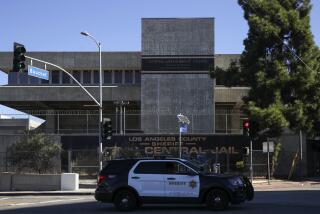Brown drops plan for new death row
SACRAMENTO AND LOS ANGELES — Gov. Jerry Brown on Thursday canceled construction of a $356-million death row at San Quentin prison, saying it would be “unconscionable” to spend so much on condemned inmates as the state is slashing budgets for education and other social services.
“At a time when children, the disabled and seniors face painful cuts to essential programs, the state of California cannot justify a massive expenditure of public dollars for the worst criminals,” Brown said in a statement.
The cancellation will save the state’s general fund $28.5 million a year for 25 years, the cost of financing the construction loan, said Brown spokesman Gil Duran.
Previous administrations spent about $20 million on planning and design for a two-building complex, Duran said.
The project was approved in 2003, before the global financial crisis opened a gaping hole in the state budget.
“Obviously, this idea began in better financial times,” said prison spokesman Oscar Hidalgo, adding that the corrections department delayed awarding the construction contract to give the new governor a chance to review the expenditure.
Construction of a death row to accommodate the growing population of condemned prisoners has been fiercely debated.
California taxpayers spend more on prisons than any other service except education, and the cost of keeping an inmate on death row is more than three times the annual upkeep of other prisoners, according to research conducted for the bipartisan California Commission on the Fair Administration of Justice.
The corrections department puts the figure for each inmate’s incarceration at $44,500 a year, but Hidalgo said there was no breakdown for death row prisoners.
The new facility would have had room for 1,152 condemned inmates and housed visitor, medical and mental health facilities to cut down on the cumbersome and costly need to escort death row prisoners around the wider institution, Hidalgo said.
California now has 713 condemned inmates, 18 of whom are women housed at separate prisons.
Conditions on the existing death row are “just dismal,” said Donald Specter, director of the Prison Law Office, which advocates for inmates’ rights.
The cells are cramped, old and dilapidated, he said, and don’t offer prisoners enough room to exercise.
The worst conditions, including bird and rodent infestation and a plumbing problem that created “stalactites of human detritus” hanging over balconies, were cleaned up in response to a lawsuit a few years ago, Specter said.
Despite the hardship for inmates, Specter expects Brown’s cancellation of the facility to be politically popular, especially given the budget crisis.
“I’m sure most folks don’t want prisoners to be comfortable, and they certainly are not,” he said.
Death penalty advocates and many elected officials also praised the move.
“I am glad to see that Gov. Brown has made the right choice to save millions of taxpayer dollars instead of wasting money to expand upon the prison,” said Rep. Jeff Denham (R-Atwater), who opposed plans for the new death row when he was a member of the state Legislature.
He wanted to close San Quentin and sell the large waterfront site for private development.
Kent Scheidegger, legal director of the Criminal Justice Legal Foundation, which supports capital punishment, also applauded the decision.
“I don’t think we need a new death row, either. What we need to do is carry out the judgments we already have,” Scheidegger said, calling on the state’s leadership to step up the pace in clearing the legal hurdles to resuming executions.
Assemblyman Jared Huffman (D-San Rafael) also praised the governor’s action.
The proposed complex “was going to be a ‘Cadillac death row’ -- hugely expensive and ill-conceived,” he said.
Brown’s move comes not only amid a budget crisis but also at a time when the future of capital punishment in California seems uncertain.
There are no lethal injections pending, Hidalgo said, while a legal challenge to the three-drug cocktail used to kill inmates works its way through the courts.
Brown has expressed his personal objection to capital punishment but has also vowed to respect the will of the majority of Californians, who have said they want to keep the death penalty as a sentencing option for the worst criminals.
Thursday’s order had nothing to do with the governor’s personal aversion to the death penalty, Duran said: “This is purely about dollars and cents.”
Polls show that a majority of Californians support capital punishment, although that support has declined as people have become aware of the spiraling costs of maintaining death row.
--
carol.williams@latimes.com
More to Read
Sign up for Essential California
The most important California stories and recommendations in your inbox every morning.
You may occasionally receive promotional content from the Los Angeles Times.












